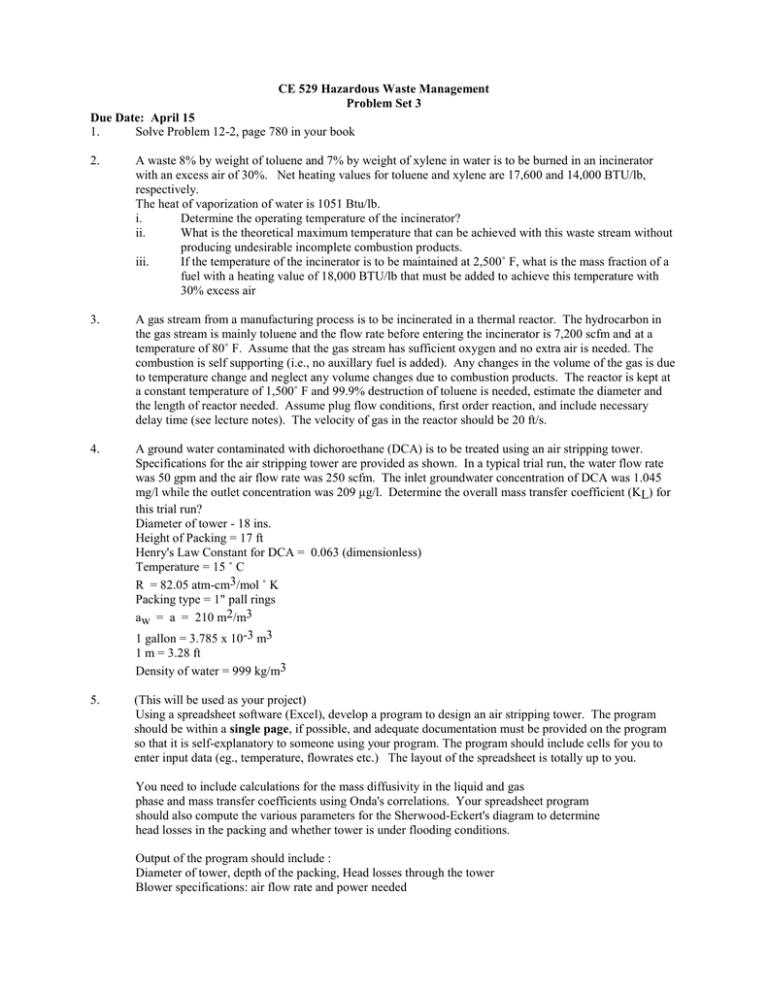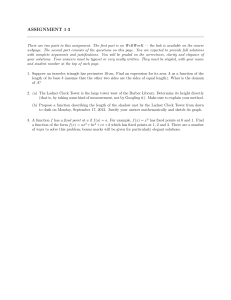CE 529 Hazardous Waste Management Problem Set 3 1.
advertisement

CE 529 Hazardous Waste Management Problem Set 3 Due Date: April 15 1. Solve Problem 12-2, page 780 in your book 2. A waste 8% by weight of toluene and 7% by weight of xylene in water is to be burned in an incinerator with an excess air of 30%. Net heating values for toluene and xylene are 17,600 and 14,000 BTU/lb, respectively. The heat of vaporization of water is 1051 Btu/lb. i. Determine the operating temperature of the incinerator? ii. What is the theoretical maximum temperature that can be achieved with this waste stream without producing undesirable incomplete combustion products. iii. If the temperature of the incinerator is to be maintained at 2,500˚ F, what is the mass fraction of a fuel with a heating value of 18,000 BTU/lb that must be added to achieve this temperature with 30% excess air 3. A gas stream from a manufacturing process is to be incinerated in a thermal reactor. The hydrocarbon in the gas stream is mainly toluene and the flow rate before entering the incinerator is 7,200 scfm and at a temperature of 80˚ F. Assume that the gas stream has sufficient oxygen and no extra air is needed. The combustion is self supporting (i.e., no auxillary fuel is added). Any changes in the volume of the gas is due to temperature change and neglect any volume changes due to combustion products. The reactor is kept at a constant temperature of 1,500˚ F and 99.9% destruction of toluene is needed, estimate the diameter and the length of reactor needed. Assume plug flow conditions, first order reaction, and include necessary delay time (see lecture notes). The velocity of gas in the reactor should be 20 ft/s. 4. A ground water contaminated with dichoroethane (DCA) is to be treated using an air stripping tower. Specifications for the air stripping tower are provided as shown. In a typical trial run, the water flow rate was 50 gpm and the air flow rate was 250 scfm. The inlet groundwater concentration of DCA was 1.045 mg/l while the outlet concentration was 209 µg/l. Determine the overall mass transfer coefficient (KL) for this trial run? Diameter of tower - 18 ins. Height of Packing = 17 ft Henry's Law Constant for DCA = 0.063 (dimensionless) Temperature = 15 ˚ C R = 82.05 atm-cm3/mol ˚ K Packing type = 1" pall rings aw = a = 210 m2/m3 1 gallon = 3.785 x 10-3 m3 1 m = 3.28 ft Density of water = 999 kg/m3 5. (This will be used as your project) Using a spreadsheet software (Excel), develop a program to design an air stripping tower. The program should be within a single page, if possible, and adequate documentation must be provided on the program so that it is self-explanatory to someone using your program. The program should include cells for you to enter input data (eg., temperature, flowrates etc.) The layout of the spreadsheet is totally up to you. You need to include calculations for the mass diffusivity in the liquid and gas phase and mass transfer coefficients using Onda's correlations. Your spreadsheet program should also compute the various parameters for the Sherwood-Eckert's diagram to determine head losses in the packing and whether tower is under flooding conditions. Output of the program should include : Diameter of tower, depth of the packing, Head losses through the tower Blower specifications: air flow rate and power needed To test your program, design an air stripping tower to treat a wastewater from an industrial process containing 5 mg/L of trichloroethylene and 1 mg/L of chloroform. The effluent standard before the wastewater can be discharged is 5 µg/L for both compounds. Temperature of water = 15˚ C. Wastewater flow rate is 30 gpm. Design information Packing material used is 25 mm pall rings. Use a safety factor of 20% on the calculated height of the tower. Use Onda's correlation to compute KLa (assume aw = a) Stripping factor = 2 to 7 Water loading rate = 10 to 50 gpm/ft2 Air to water ratio = 10 to 100 or higher depending on flooding conditions. Obtain Henry's Law Constants and other information from your Textbook (see Appendix A) and Wastewater Engineering, Metcalf and Eddy. Print out your spreadsheet and provide a summary of your design. 6. An air permeability test for an SVE system using forced air is presented below. Monitoring points were placed at 40, 20 and 10 feet away from the screened well. The screened portion of the venting well (4 ins. diameter) was between 6 to 10 feet below ground level. Depth of monitoring points is between 9 and 10 feet below ground level. Water table is 12 feet below ground level. Steady state air flow rate was 45 scfm. Assume temperature of soil was 15˚ C. (1) Determine the air permeability for the soil based on the data below and what type of soil is found at the site. (2) Determine the radius of influence based on the air permeability test If the contaminated site is as shown in the figure below, (i) estimate the number of extraction wells needed for the site. Assume that the bottom of the Southwest Tanks is 8 feet below the ground level. The Southwest tanks will be removed and filled with clean dirt. (ii) Estimate the air flowrate of the blower needed (assume one blower) for this site if the vacuum well pressure at each venting well is 0.8 atm. Radius of extraction well is 2 ins and length of screen is 4 feet. Screens of extraction wells are located between 6 to 10 feet. __________________________________________________________________ Test Time Pressure (inches of water) at monitoring points (min) _____________________________________________ 40 ft 20 ft 10 ft __________________________________________________________________ 0.0 0.0 0.0 0.0 0.5 0.12 0.4 1.7 1.0 0.23 1.45 4.6 1.5 0.65 2.9 7.7 2.0 1.1 3.7 9.2 2.5 1.4 4.0 10.1 3.5 1.65 5.0 11.4 4.5 2.0 5.6 12.1 5.5 2.25 6.0 12.6 6.5 2.50 6.2 12.7 7.0 2.6 6.3 12.8 7.5 2.7 6.40 12.80 8.5 2.9 6.50 12.60 9.5 2.95 6.55 12.60 10.5 3.05 6.60 12.60 14.0 3.05 6.60 12.60 7. Design a granular activated carbon adsorption system for a hazardous wastewater containing a mixture of organic compounds with a flow of 1,500 m3/day. The organic compounds in the wastewater are expressed in terms of total organic carbon (TOC) at a concentration of 228 mg/L. Design a system to remove 90% of the TOC. A pilot scale study was conducted using three columns of 5 cm (2 in) in diameter and 2 m (6.6 ft) high with a flow rate of 5.5 m3/day. Bulk density of the carbon is 481 kg/m3. Use both the BDST method and the kinetic method. Compare answers and comment on the results. Time (days) 33 38 41 43 45 49 53 58 63 66 69 72 75 78 83 87 94 100 Concentration of TOC in effluent (mg/L) Column 1 Column 2 212 6.8 221 20.5 223 34.2 226 45.6 228 79.8 228 148 178 205 217 221 226 227 228 Column 3 0 6.8 18.2 31.9 52.4 91.4 125 182 210 221 228 228






